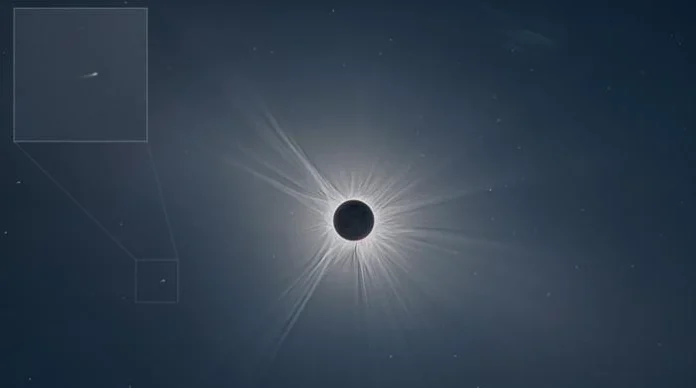Astrophotographer Petr Horálek achieved a remarkable milestone by capturing a rare photograph of a comet, designated as “SOHO-5008,” during the solar eclipse on April 8 in North America.
This event was particularly special because the comet was observed moving towards the Sun during the eclipse, presenting a unique and mesmerizing sight that few have had the opportunity to witness and document.
Comets are intriguing celestial bodies that are often likened to large snowballs composed of dust, ice, and rocky material. These icy objects orbit the Sun in elliptical paths, spending most of their time in the cold outer regions of the solar system.
When their orbits bring them closer to the Sun, the increasing solar heat causes the frozen surface of the comet to sublimate, releasing dust and gases into space.
This process leads to the formation of a glowing coma and a characteristic tail that can extend for millions of miles, making comets one of the most visually striking phenomena in the night sky.
While comets may seem rare and elusive, they are actually relatively common in our solar system. According to data from the Solar and Heliospheric Observatory (SOHO), astronomers have identified and cataloged over 5,000 comets to date.
Each comet has its own unique orbital path, size, and composition, offering scientists valuable insights into the formation and evolution of our solar system.
Leading up to the solar eclipse, Karl Battams, the head of the Sungrazer project, had predicted that SOHO-5008 would make a visible appearance during the event.
To Horálek, a multitude of astrophotographers, amateur astronomers, and stargazers worldwide were also eagerly awaiting the opportunity to observe and capture images of the comet.
Worachate Boonplod, an amateur astronomer from Thailand, reported spotting a particularly bright comet in the Kreutz orbit just hours before the eclipse reached totality, adding to the excitement and anticipation surrounding the event.
The practice of observing and studying comets is a tradition that spans centuries, with some of the earliest recorded sightings dating back to ancient civilizations.
The Great Comet of 1680, for instance, was a spectacular sight that was visible to the naked eye for several months, captivating the imagination of people around the world and inspiring scientific curiosity.
Another significant event occurred in May 1882 when a group of astronomers traveled to Egypt specifically to observe a solar eclipse.
To their astonishment and delight, they were greeted with the unexpected sight of a comet appearing alongside the eclipse, creating a stunning celestial tableau that added an extra dimension of wonder to their scientific expedition.
Comets continue to fascinate and inspire awe among scientists, astronomers, and stargazers alike. They serve as both celestial marvels and valuable cosmic laboratories, offering unique opportunities to explore and understand the history, composition, and dynamics of our solar system.
Through dedicated observation, research, and photography, individuals like Petr Horálek and others contribute to the ongoing quest to unravel the mysteries of these enigmatic and beautiful objects that grace our night skies.


